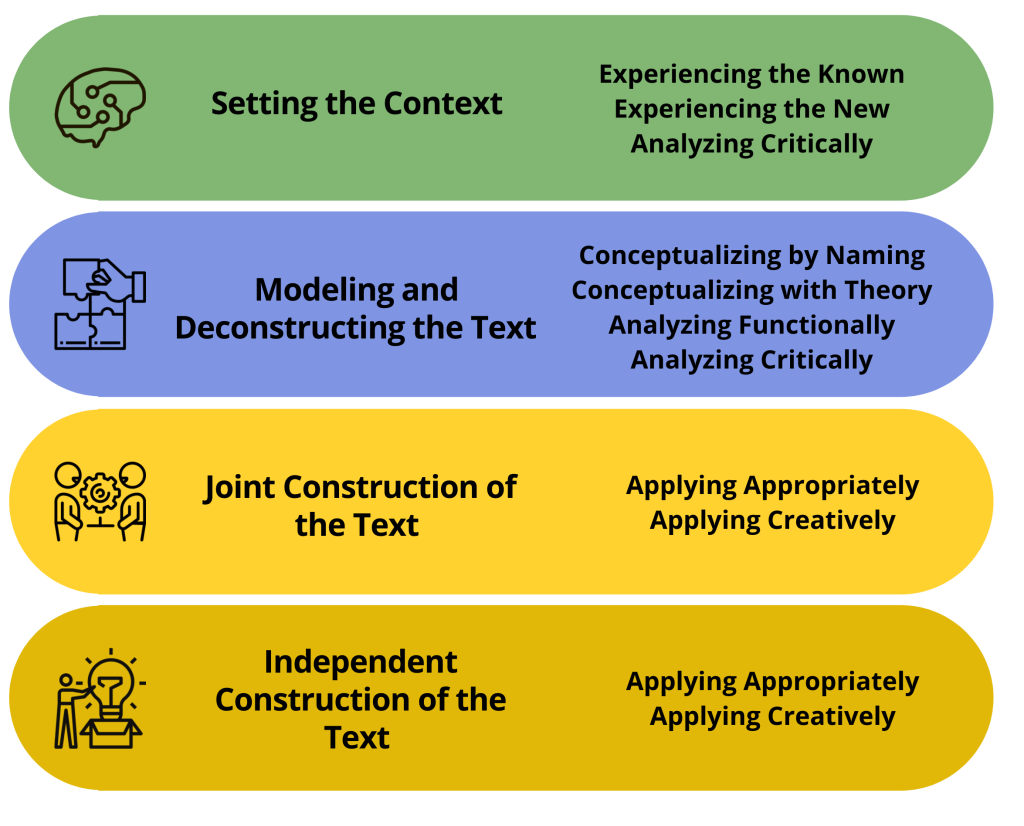
Objectives
The main objective of this course is to help students develop their writing skills in Spanish. Students will work with authentic, open-source multimodal materials in order to:
- Reflect on their knowledge of a particular topic and be exposed to new perspectives on it;
- Conceptualize essential aspects of the content and formulate connections to concepts and theory;
- Analyze and understand linguistic and discursive aspects from a functional (how meaning is expressed) perspective, and critically examine what perspectives, interests, and motives are presented; and
- Apply their new knowledge creatively in related, academic written (e.g., producing a similar text on a different topic) and/or multimodal tasks (e.g., developing an infographics).
Learning Outcomes
Students will:
- Demonstrate presentation skills in writing and speaking through essays, presentations, and other multimodal projects.
- Demonstrate interpretive communication skills by reading, listening to, and viewing authentic materials.
- Demonstrate an understanding of major ideas as well as important information using effective reading, listening, and viewing strategies to interpret authentic materials.
By the end of the course students:
- Will have expanded their knowledge of the structural and functional (meaning) aspects that characterize the following kinds of texts in Spanish: expository, narrative, descriptive, and informational.
- Will be able to apply this knowledge in the development of different written and multimodal tasks within the four genres discussed in class.
- Will have participated in class discussions and oral, multimodal presentations, and will be able to clearly state and support ideas providing evidence from the content discussed in class.
- Will have gained and demonstrated appreciation of Hispanic/Latinx cultures’ customs, practices, products, and perspectives on different topics.
Pedagogical Approach
Instruction in this book is guided by the tenets of two frameworks, the multiliteracies approach Learning by Design (Kalantzis, Cope, & Zapata, 2019; Zapata, 2022) and Genre-Based Instruction (Hyland, 2014; Troyan, 2021). These approaches are combined in each module as follows (Genre-Based Instruction’s cycle [in blue]; Learning by Design’s knowledge processes [in color]):
 Source: Zapata, 2022, p. 83. For more information on the book and instructional approach, contact the author, Dr. Gabriela C. Zapata.
Source: Zapata, 2022, p. 83. For more information on the book and instructional approach, contact the author, Dr. Gabriela C. Zapata.
Recommended Reading
Learning by Design (and L2/HL Instruction)
Open Chapters:
- Zapata, G. C. (2022). Chapter 1: Introduction to Learning by Design. Licensed under CC BY-NC-ND 4.0. Available at https://library.oapen.org/bitstream/handle/20.500.12657/54053/9781003106258_10.4324_9781003106258-1.pdf?sequence=1
- Zapata, G. C. (2022). Chapter 2: Learning by Design and second language education. Licensed under CC BY-NC-ND 4.0. Available at https://tandfbis.s3.us-west-2.amazonaws.com/rt-files/docs/Open+Access+Chapters/9781003106258_10.4324_9781003106258-2.pdf
- Zapata, G. C. (2022). Chapter 3: Learning by Design and second language teaching practices. Licensed under CC BY-NC-ND 4.0. Available at https://library.oapen.org/bitstream/handle/20.500.12657/54055/9781003106258_10.4324_9781003106258-3.pdf?sequence=1
Other Resources:
- Cope, B., & Kalantzis, M. (2015). The things you do to know: An introduction to the pedagogy of multiliteracies. In B. Cope & M. Kalantzis (Eds.), A pedagogy of multiliteracies: Learning by design (pp. 1–36). Palgrave Macmillan.
- Kalantzis, M., & Cope, B. (2012a). Literacies. Cambridge University Press.
- Kalantzis, M., & Cope, B. (2012b). New learning: Elements of a science of education (2nd ed.). Cambridge University Press.
- Kalantzis, M., Cope, B., & the Learning by Design Project Group (2005). Learning by Design. Victorian Schools Innovation Commission and Common Ground Publishing.
- Kalantzis, M., Cope, B., Chan, B., & Dalley-Trim, L. (2016) Literacies (2nd ed.). Cambridge University Press.
- Kalantzis, M., Cope, B., & Zapata, G. C. (2019). Las alfabetizaciones múltiples: Teoría y práctica [Multiliteracies: Theory and practice]. Octaedro.
- Zapata, G. C. (2022). Learning by Design and second language teaching: Theory, research, and practice. Routledge. Google book preview: https://bit.ly/3Mcrpua.
- Zapata, G. C., & Lacorte, M. (Eds.) (2017). Multiliteracies pedagogy and language learning: Teaching Spanish to heritage speakers. Palgrave Macmillan.
- Zapata, G. C., & Ribota, A. (2021b). Chapter 1: Open educational resources in heritage and L2 Spanish classrooms: Design, development, and implementation. In C. Blyth & J. Thoms (Eds.), Open education and foreign language learning and teaching: The rise of a new knowledge ecology (pp. 25-46). Multilingual Matters. https://doi.org/10.21832/9781800411005-003
Genre-Based Instruction
- Derewianka, B. (1990). Exploring how texts work. Primary English Teaching Association.
- Glisan, E. W., & Donato, R. (2021). Enacting the work of language instruction: High-leverage teaching practices (Volume 2). ACTFL.
- Hyland, K. (2014). Genre and second language writing. The University of Michigan Press.
- Troyan, F. J. (Ed.) (2021). Genre in world language education: Contextualized assessment and learning. Routledge.
Multiliteracies and L2 Instruction
- Allen, H.W., & Paesani, K. (2010). Exploring the feasibility of a pedagogy of multiliteracies in introductory foreign language courses. L2 Journal, 2, 119–142. https://doi.org/10.5070/L2219064
- Paesani, K., Allen, H. W., & Dupuy, B. (2015). A multiliteracies framework for collegiate foreign language teaching. Pearson.
- Warner, C., & Dupuy, B. (2018). Moving toward multiliteracies in foreign language teaching: Past and present perspectives…and beyond. Foreign Language Annals, 51, 116–128. https://doi.org/10.1111/flan.12316
Atribuciones de los medios
- GBI and L-by-D
